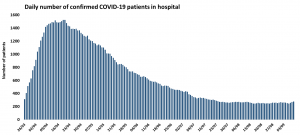Statistics
Counting people in hospital with COVID-19
September 15, 2020 by Office of the Chief Statistician 2 Comments | Category Uncategorized
We are changing the way we count people in hospital with confirmed COVID-19 as of 15 September 2020. The new figures are lower than the previous published management information and we have a break in the time series. This blog explains why and how.
Current situation
Every day since mid-March, the Scottish Government has been collecting data on the number of confirmed COVID-19 patients in hospital from across NHS Scotland. This data collection was set up quickly to meet an immediate need to understand the impact this new illness was having on our NHS hospitals. It was important to take a pragmatic approach to this in order to avoid any additional work for hospital staff, so while an approach was defined, local areas adopted the best way to extract this from their information systems.
The measure showed a rapid increase in the number of confirmed COVID-19 patients in hospital to over 1,500 in mid-April, reflecting the situation at the time. However, the measure stabilised at around 250 into July and August. Data published daily on coronavirus.data.gov.uk shows that on 26 August, for example, there were 442 COVID-19 patients reported in hospitals in England, 48 in Wales and 17 in Northern Ireland, compared to 249 in Scotland.
In addition, data from Public Health Scotland shows that the numbers of new hospital admissions where COVID-19 was confirmed were relatively low through July and August. In early July, additional information on hospital onset
cases became available, and it was apparent that there were different types of inpatients being included in the figures provided each day by NHS boards, including those who have tested positive for COVID-19 at some point but are no longer being treated for COVID-19.
Investigation
On 26 August, we carried out a snapshot clinical audit to find out more about the relative contribution to the numbers of these different categories of patients (see below). In addition to using the available administrative information, this work involved clinicians in order to fully understand the status of current inpatients. The audit confirmed that the majority of COVID-19 inpatients reported in the daily published statistics were in hospital for an ongoing condition following a resolved COVID-19 infection, or for a condition unrelated to COVID-19. The majority of these were in the two largest Health Boards (Greater Glasgow & Clyde and Lothian), while some other Boards had previously adapted their own definitions to only include current cases, for example Fife did this in June resulting in a decrease in their figures.
Audit findings
The audit of inpatients identified 384 patients in hospital at 1am on 26 August across Scotland who had previously tested positive for COVID-19.
The majority of these patients (87%) were in hospital for a condition unrelated to COVID-19:
- 45% were hospital onset cases who were no longer being isolated or treated for COVID-19;
- 25% had recovered from COVID-19, been discharged and then readmitted for an unrelated condition;
- 9% had a previous positive COVID-19 test in the community, and were admitted for an unrelated reason
- 8% had been admitted for COVID-19, had recovered but were still in hospital for other reasons.
The audit showed that 8% of patients were either receiving treatment for COVID-19, were in rehabilitation after their treatment for COVID-19 was completed, or were in hospital for COVID-19 related complications. (5% of patients could not be classified into the above categories.)
What’s changing?
In order to make sure we are not counting people who are no longer being treated for COVID-19, we are introducing standard time periods after testing positive for hospital inpatients to remain included in the figures. Only patients who first test positive in their current hospital admission (or in the 2 weeks before admission) will be included. And they will stop being counted after 28 days in hospital (or after testing positive if that is later).
Because this is essentially a statistical rather than clinical definition, there will potentially be some patients who are still in hospital and ICU because of COVID-19 who will no longer be counted after 28 days. But overall, by making sure we are excluding those inpatients with a previous positive COVID-19 test who are now in hospital and ICU for unrelated reasons, the information will be more representative of the current situation in hospitals and more sensitive to any changes caused by new cases. We will keep this under review.
Comparing the initial data, it’s clear to see the impact of the change. The total number of confirmed COVID-19 inpatients under the previous definition was 262 on Tuesday 15th September while the new definition included 48 patients. Of these, 7 were in ICU on the old basis, and 6 under the new definition. We will no longer collect the data on the original basis.
Defining the measures in this way means that the data can be extracted from local information systems without requiring clinical input. This is a pragmatic solution that will ensure we are better placed to capture the impact of the evolution of the pandemic.
Comments
Leave a comment
You must be logged in to post a comment.


I found this summary of the Audit useful, however would very much like to read the full report and also find out what the the primary reason for admission was for the 384 patients audited on 26 August.
Unfortunately the full results of the audit have not been made publicly available to prevent disclosure due to the small numbers of patients in the detailed categories. The audit did not collect information on the primary reason for admission, apart from whether or not it was for COVID-19.